Labor continues to be one of the greatest challenges facing dairy producers across the nation, and recent legislation is adding more pressure. An increasing number of state legislatures have passed agriculture overtime laws in the last few years reducing the overtime threshold to 40 hours, including California, New York, Washington and Oregon.
These states follow in Hawaii’s footsteps in adopting a 40-hour overtime threshold. Other states, such as Minnesota, Maryland and Colorado, have adopted varying overtime requirements.
While these four states have different laws, timelines and requirements, one commonality is the trend toward increased automation on dairy farms, especially as on-farm labor becomes more expensive and more difficult to find. Automation can take many forms, ranging from adding an automated teat sprayer in a rotary parlor to transitioning to robotic milking systems, feed pushers, alley scrapers, calf feeders and more.
CALIFORNIA
Starting Jan. 1, 2022, California employers with 26 or more employees were required to pay 1.5 times the regular pay rate for more than eight hours worked in a day and 40 hours in a workweek. This will go into effect for employers with 25 or fewer employees on Jan. 1, 2025 (see Table 1).
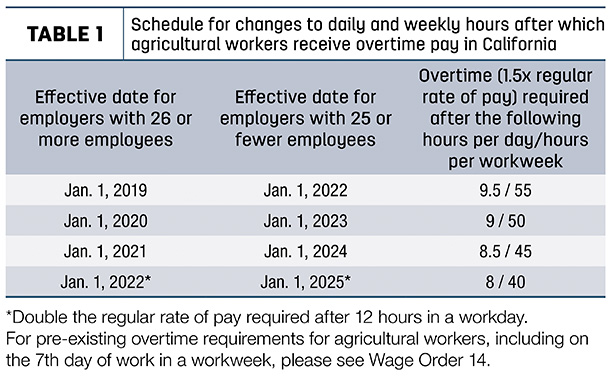
Ryan Calistro with Total Dairy Solutions in California says that compared to other states, California’s minimum wage, labor rates and laws are causing customers to find solutions more quickly than in other markets. Some of those solutions include automated calf kitchens, automated pre- and post-dip applications in the parlor, robotic milking systems, automated feed centers, robotic feed pushers and more. He also sees dairies decreasing the milking frequency in traditional parlors.
“Aside from automating, we have quite a few customers that have reduced milking frequency from 3X to 2X, which allows for a reduction in crew and fewer hours milking,” Calistro says. “Another thing I’ve noticed is the elimination of positions altogether.”
Megan Silva is a partner with her dad, Frank Rocha; and husband, Johnny, at their two dairies in Escalon, California. They milk 2,200 cows at their main dairy and 550 at a dairy nearby they purchased in 2019. Finding good labor or, in some cases, “any labor at all” is one of the biggest challenges facing dairy farmers in her area right now, she says.
“The ag overtime law has negatively affected our farm, and we are just at the beginning,” Silva says. “At the main dairy, we made changes to milker shifts and some other positions. We have already seen our labor costs rise, and this is just the first step in moving toward an eight-hour workday and 40-hour workweek.”
In April 2022, they added DeLaval VMS300 robots and reconfigured job descriptions, replacing milking positions with roles where employees can participate in the new technology while spending more time tending to the cows and their environment.
How are employees responding to their new responsibilities? With excitement, she says.
“Not only are we excited, but so are our employees,” Silva says. “They are learning, growing and adapting right alongside us, and it’s great to see. We set new expectations and our employees have risen to them. We are extremely grateful to them for their willingness to trust us and grow with us.”
The new technology changes but does not replace management, she says.
“I’ve heard people say, ‘I guess you can hit autopilot and not worry too much about that place now,’ but it’s quite the opposite,” Silva says. “One of my favorite sayings is ‘If you can measure it, you can manage it,’ and the technology provides so much information on each cow and robot for us to measure. However, it still takes time to pull reports and analyze the data, and you still must walk your cows, check incomplete lists, health lists and so much more. It’s not less work; it’s different work.”
NEW YORK
As of Jan. 1, 2020, the Farm Laborers Farm Labor Practices Act (FLFLPA) requires employers to pay farmworkers in New York overtime above 60 hours per week.
A bill on the governor’s desk at the time this article was written would transition the 60-hour threshold to 40 hours over a 10-year period, decreasing by four hours each year starting in January 2024.
Some producers are moving forward with robotic milking systems – or planning to – and some are waiting to see what happens next, says Whitney Davis, capital sales director at Finger Lakes Dairy Services, Inc.
“Overtime has a substantial impact,” Davis says. “Putting overtime aside, labor is going to be more and more expensive and, in many cases, it has outpaced the cost of the equipment.”
Davis sees potential for automation in many scenarios, including those used by Hemdale Farms and Oak Orchard Dairy in New York.
Hemdale Farms – owned by Dale Hemminger and his son, Clay – first installed their robotic milking system in 2007, and the dairy has since expanded from 550 cows in a parlor to 1,500 cows with 22 box robots while doubling milk shipped per man-hour. Hemminger says he’s had to make some adjustments due to the overtime law, but that it has gone reasonably well.
“Since transitioning to the robotic milking system, we were already trying to limit hours to 60 to 66 per week, and the new law has us focused on 60 or less at the dairy,” Hemminger says. “The crops are so weather-dependent, particularly in the spring, that we continue to work the hours needed to focus on soil health and make the most of perfect planting and forage harvesting conditions. We previously had a bonus system for employees’ commitment to getting the job done and working long hours in the fields, so the new overtime, for the most part, was already being paid on the crop side of the business.”
Hemminger says the law will likely hurt the competitiveness of dairies in the state.
“If we get down to the 40-hour overtime threshold, our increased labor cost with overtime paid will be a serious blow to our ability to compete with other states, Canada and the world,” Hemminger says. “Many of the traditional family farms that only have a few non-family member employees are still adjusting to 60 hours – and if we ratchet down to 40, they might not be competitive. I just hope families see the future and make smart decisions before they burn their equity up trying to survive. On our farm, we are avoiding any meaningful expansion with permanent structures, knowing New York state may not be a competitive place to be progressive moving forward.”
Elba dairyman Curt Norton, owner of Oak Orchard Dairy, started the process of adding robots with this overtime law and wage increase in mind. He built a 450-cow barn with space for eight robotic milking systems. The first four Lely A4s were installed while adding 200 cows to the dairy with no additional labor. Last year, the other four Lely A5s were installed, and this reduced the need for two employees, resulting in a 15% decrease in total labor last year.
“We pushed really hard to get the robot barn completed,” Norton says. “Our wages increased 7.5 percent with overtime at 60 hours and the increased minimum wage at 13 dollars and 40 cents. This law will push us to add more robots, cut more labor and increase other automation, such as alley scrapers.”
He says he has also seen many other dairies move toward automated milking systems or add robotics to existing rotary parlors to decrease labor.
John Dickinson, Northeast Dairy Producers Association chair and partner at Ideal Dairy in Hudson Falls, New York, noted some of the additional effects of the 60-hour overtime threshold that went into effect in 2020.
“Since 2020, labor costs have significantly increased,” Dickinson says. “Other effects we are seeing include concern from farmworkers about losing hours and money if the threshold is lowered further, utilization of custom services where possible, labor shortages across the supply chain, and some farms are also investing in labor-saving technologies, like robotic milking systems.”
Washington
Washington’s agriculture overtime law went into effect in 2021 for dairy farmers, while other agricultural industries have a three-year transition to 40 hours (see Table 2).
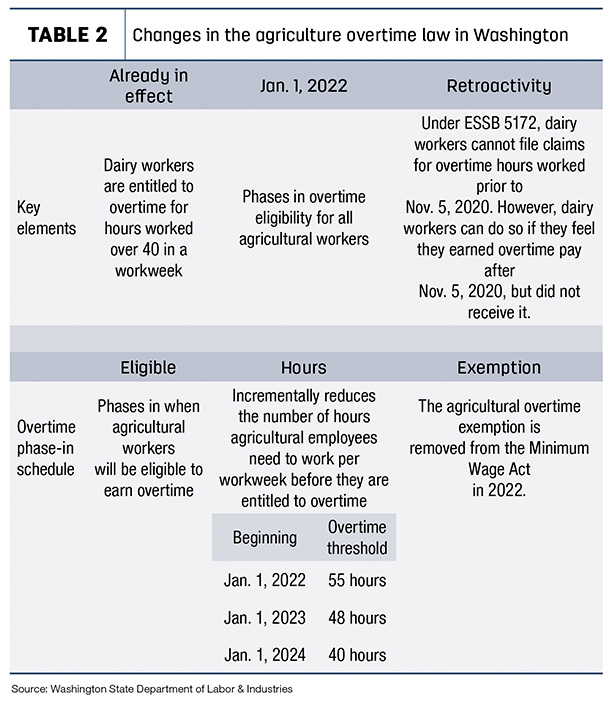
“Overtime has had a rather chilling or depressing effect on dairy farms,” says Jay Gordon, policy director for the Washington State Dairy Federation. “We are losing one later this month that puts partial blame on the overtime law.”
Mark Troupe, field manager with Northwest Dairy Association, says he knows of 72 new robotic milking systems installed in the last year and 30 more in the works in Washington.
Robotic milking systems are becoming more popular on dairy farms across western Washington as a method of addressing the labor issue, according to Michelle Schilter of Sun-Ton Farms in Chehalis, Washington.
“We installed four Lely A5 robotic milking systems after struggling for the past three years to find dependable and reliable employees,” Schilter says. “The new law forced us to make some difficult decisions to be able to continue operating our dairy in the current location.”
She says the law also limited who they could hire.
“We are not able to pay overtime, so we needed to be very specific when searching for a new employee that will only work 45 hours per week,” Schilter says. “Our employees did not understand why changes were made to their work schedules and were concerned that their wages were being reduced. It was difficult to explain why these changes were made and that we were forced to make these changes due to the new law.”
OREGON
Oregon’s legislature passed an agriculture overtime bill during the 2022 session, which goes into effect on Jan. 1, 2023, starting at 55 hours. The law decreases the overtime threshold to 48 hours in 2025 and 40 hours in 2027.
“There’s lots of conversation among producers about how to make it work, how to track hours, how to cut hours, etc.,” says Tami Kerr, executive director of Oregon Dairy Farmers Association. “We are still wrapping our heads around the new law, but everything is on the table for producers, including automation and selling out. This law will disproportionally hurt smaller producers.”
Kurt Mizee of Tilla-Bay Farms in Tillamook, Oregon, installed a Lely robotic milking system in 2011 and later automated his feeding system and other processes across the farm. He says he is hearing a “definite increase” in interest by dairy producers in looking at or reassessing previous bids and plans for automation.
“If the last few years have shown us anything, it is that labor cost will continue to rise and labor will become scarcer,” Mizee says. “As labor costs rise, the cost analysis changes because now that expensive technology is replacing expensive labor. In our area, we also must provide housing for employees, and this compounds the issue of hourly positions and reasonable wage. The Oregon coast market is challenging, with starter homes in the $400,000 range and rentals unavailable since we are in a vacation home market. Most farm labor is priced out of both rental and purchase options.”
Producer Q&A
1. What should dairy farmers in states without agriculture overtime laws (yet) know about how this type of law may affect them in the future?
2. What advice do you have for other farms considering automating some of the labor-intensive parts of their farm?
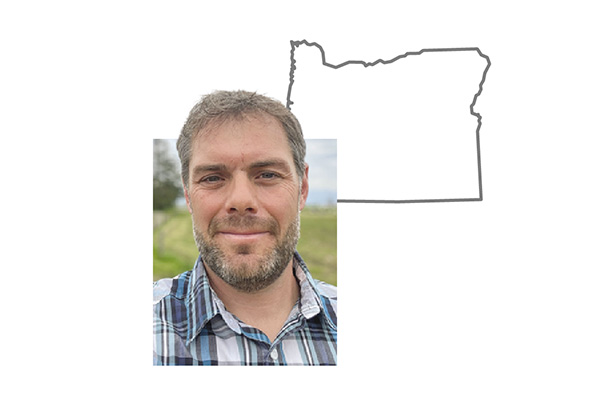
Kurt Mizee
Tilla-Bay Farms
Tillamook, Oregon
1. I suggest producers in states that haven’t passed ag overtime laws yet start getting a plan together. How will you transition? Do you already track hours? Are your employees hourly? Do your non-hourly employees meet the criteria for salary? Are you looking for ways to reduce labor?
Some ways of reducing labor that may have been out of reach previously suddenly make more sense when overtime pay, additional employees (and the turnover and onboarding that comes with it) comes into play. The legislation was pushed by large, national labor groups and won’t stay contained to the states where it has already been enacted.
2. Consider which technologies are proven. Unless you want to be part of the research and development process, units in the field matter. How good is the support for the product both locally and from corporate? Technology is expensive. If you are going to make the investment, take the time to see as many operations as you can. The more the operation you are looking at resembles your own, the better. Talk to the farmer without the salesman and ask about the maintenance costs and what kind of service is required. Service and maintenance can make cheaper technology options more expensive in the long run.
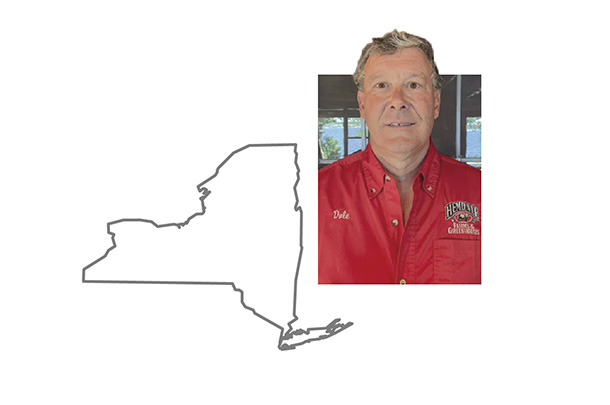
Dale Hemminger
Hemdale Farms
Seneca Castle, New York
1. I ordered our first four robots 15 years ago this month, and we shut our parlor down over 12 years ago. At that time, I expected labor to get tougher or almost impossible, particularly with immigration concerns. To my surprise, this didn’t come for 10 years, but now has come all at once. Other states certainly may have an advantage for a period of time, but history would suggest it will get tougher everywhere.
2. It is not a cure-all or quick fix. You must want to do it and embrace technology and change. Startup issues are a challenge with any expansion and change, so give yourself a few months to breathe and learn with additional labor around. The cows get there in three weeks; the question is: How long does it take the staff and owners?
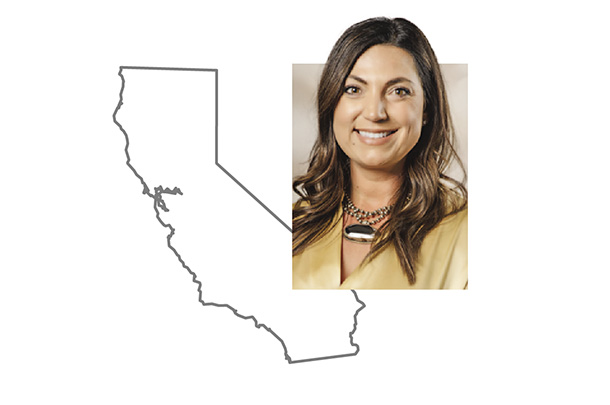
Megan Silva
Frank N. Rocha Dairy and R&S Dairy
Escalon, California
1. I think they should pay close attention to how California farmers are handling their businesses going forward. Luckily for them, they most likely will not have to reinvent the wheel. I believe that keeping up with new technologies is going to be extremely important in the future for reasons more than just the labor and overtime issues.
2. My advice would be to understand that with automation still comes management. Tour other facilities using automation and ask the tough questions. We all dairy differently, and just because something works for one dairy doesn’t mean it will work for all.
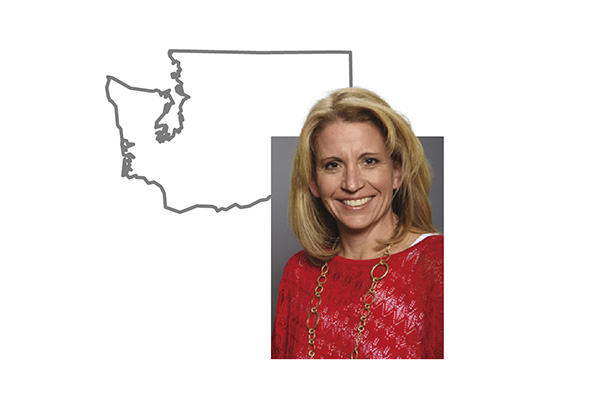
Michelle Schilter
Sun-Ton Farms
Chehalis, Washington
1. I would start by saying: If you reside in a state that currently does not have an ag overtime law, expect it and know it will happen eventually. In my opinion, it is a waste of valuable time and resources to try and fight this labor issue. Instead, I recommend using the time and resources to find ways to innovate your farm so that eventually those labor issues will not have as big of a “disruptive” impact on your operation.
2. The time to consider automation is now. So many farms are automating their operations, so real-life experience and advice is all around you. All farmers can admit anything new looks great in a flyer or at a farm show, but real-world experience is gold. My husband and I have several close friends we can reach out to for help, advice or just some kind words. We are very happy we chose to install robots. It does not reduce our workload, but it does finally solve our labor issue. So happy for that after three long years.

Curt Norton
Oak Orchard Dairy
Elba, New York
1. Start thinking about this overtime law now because it comes like a freight train. I have also run into issues trying to cut employees’ hours to compensate, and they do not like this, as most are here to make as much as they can in three to four years.
2. Adding automation is not cheap. We have said that you are prepaying labor, and the numbers bear this out. The best advice I can give is to tour as many dairies as you can and take ideas from all of them that you like. We are not all the same, but we are all in same business. You need to have a person who is computer-savvy since you get a lot of useful data from the software. Manual labor decreases with the right barn and right robot set-up, and you need to weigh costs against increases and labor savings. Also, the labor in robot barns is much more relaxed than a parlor, so employees like it.







